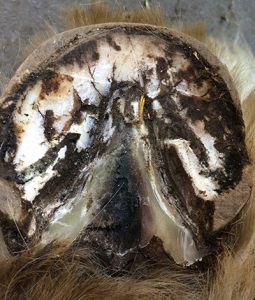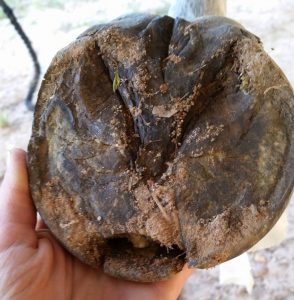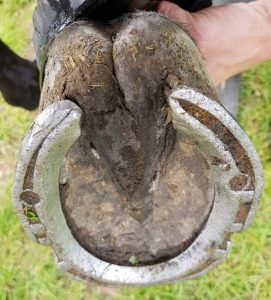- 1 November 2017
- by Sam Austin
- Hoof care
Sam Austin from Red Horse Products tells us about some common hoof infections and how to treat them without making matters worse in the long term. So you can best advise your customers on which products to use. Originally published in Equestrian Business Monthly.
It is now well accepted that the better the structure and shape of a horses foot the sounder that horse will be. Although many hoof infections do not directly affect soundness they can adversely influence the structure and stability of the horses hoof leading to lameness or sub-clinical problems (poor performance). Unfortunately apart from the very obvious thrush these can often go unnoticed by owners and hoof-care professionals alike.
Here is a quick breakdown of the more common hoof infections, all of which thrive on poor quality hoof in unclean, anaerobic (lacking oxygen) environments such as stables or mud.
Thrush – a surface fungal & bacterial infection primarily caused by Spherophorus neaophorus Fungus. It causes a black slime to form on and around the frog, spreading onto the sole. Thrush is only lameness causing in severe cases but the fungus breaks down sole tissue causing thinning of the soles and more prone to bruised soles, abscessing and other hoof infections.
Signs: Black covering to the frog and in clefts either side, cheesy smell, black veined appearance to the sole.

White Line Disease (WLD) – The inner hoof wall becomes infected with anaerobic fungi, bacteria or even viral pathogens which cause a split in the white line. As the micro organisms break down the white line tissue the pocket becomes deeper and allows dirt and stones to enter opening it wider still. WLD causes visible lameness when it becomes deep and causes weakening of the hoof structure – for example a WLD affected area of hoof wall will find it hard holding shoe nails without cracking and be prone to infections. A deep area of white line disease at the tip of the toe is know as ‘Seedy Toe’
Signs: Areas of black or grey inside the hoof wall (under the shoe if shod), dirt or gravel in white line and a chalky appearance to the inner hoof wall. Again use your nose – a milder smell than thrush.

Deep Central Sulcus (DCS) – microorganisms infect the central sulcus or cleft of the frog. In a similar way to WLD this split deepens, is infiltrated by dirt and further infected. This fissure can cause sub-clinical lameness (manifested by loss of performance, shortness of stride and ‘footyness’) and can spread all the way into the digital cushion causing severe lameness.
Signs: Thrushy area in middle of frog progressing into a split in the middle of the frog which can be parted with a hoof pick – often accompanied by thin, contracted frogs.

Treating Hoof Infections
This is where horse owners are often misguided into using a short term fix that in the long term will encourage re-infection. Prevention, as always is better than cure – a strong, well shaped hoof with dense, healthy tissue provides much less opportunity for microbial invasion. Therefore it is important that whilst treating infection that horn health is kept in mind.
Common treatments, especially for thrush focus exclusively on killing the fungi and bacteria in the hoof. But often these treatments (strong peroxide, tar, iodine, bleaches, borax & formaldehydes) are so strong that they kill live hoof tissues and break down dead ones. Bacteria and fungi thrive on dead tissue so although the infection will likely be destroyed it will usually return rapidly and much worse.
Ideal management of these infections should consist of the following
a) Provision of a healthy environment. Away from mud, urine and droppings etc. Abrasive materials such as pebbles, river stone and ceramic beddings keep feet dry and exfoliate dead tissue.
b) Destruction of microbes, without destruction of hoof tissue. Using something like a honey, zinc sulphate, zinc oxide, or eucalyptus oil based products. All of these ingredients have powerful yet gentle antimicrobial properties.
c) Promotion of healthy re-growth to discourage re-infection. The ingredients above have also been found to promote healthy tissue re-growth. Application of beneficial pressure by packing fissures promotes re-growth from within.
d) Preventing infiltration of dirt and stones into fissures (in the case of WLD and DCS) by packing or filling.
e) Proper foot care and nutrition. Trimming away dead tissue will help provide less of an environment for microbes. Proper hoof shape promotes correct wear patterns and hence a generally healthy hoof. A correct diet will aid healthy and rapid tissue growth.

